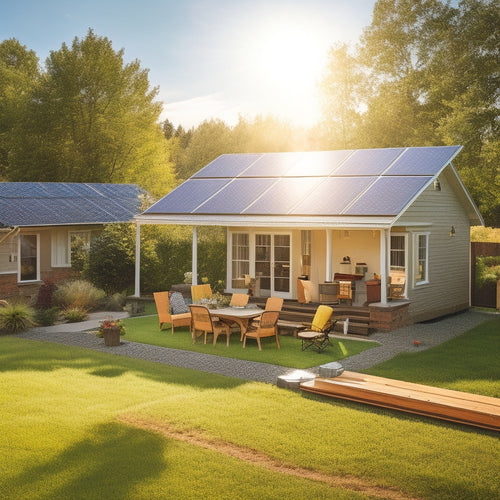
Understanding the Average Cost of Solar Panels for Your Home
Share
You're about to invest in a cleaner, more sustainable energy source for your home, and one of the biggest factors in your decision is likely the cost of solar panels. The national average price for solar panels is around $3.20 per watt, with typical residential systems ranging from $15,000 to $30,000. However, costs can vary greatly depending on factors like system size, installation timeline, and local regulations. Understanding the complexities of solar panel costs will help you make an informed decision. As you investigate your options, you'll uncover more details on how to maximize your investment and minimize your environmental footprint.
Key Takeaways
- The national average cost of solar panels is approximately $3.20 per watt, with typical residential systems ranging from $15,000 to $30,000.
- System size, influenced by energy requirements and available roof space, affects overall cost, with larger systems generally having lower costs per watt.
- Financing options, such as loans and leases, and local regulations providing incentives or rebates can significantly impact the total cost of solar panels.
- The cost per watt is influenced by equipment quality, installation timeline, and local regulations, with larger systems typically having lower costs per watt.
- Financial incentives, such as tax credits, can reduce overall costs, making solar panels a more affordable and attractive option for homeowners.
Factors Affecting Solar Panel Costs
The cost of solar panels can vary considerably depending on several key factors. As you contemplate investing in solar energy, it's crucial to understand these factors to make an informed decision.
You'll need to evaluate financing options, such as loans or leases, and maintenance costs, including repairs and replacements. Additionally, you'll want to reflect on the environmental benefits, like reducing your carbon footprint, and local regulations, which may offer incentives or rebates.
Technological advancements have improved efficiency, but installation timelines can impact upfront costs. Warranty coverage and market trends also play a role in determining the overall cost.
As you aim for energy independence, you'll need to decide whether to connect to the grid or go off-grid. By understanding these factors, you can make a well-informed decision about investing in solar panels and achieving your energy goals.
National Average Solar Panel Prices
Your solar panel investment hinges on understanding national average prices, which serve as a benchmark for your project's cost. The current national average price for solar panels is around $3.20 per watt, with the total cost ranging from $15,000 to $30,000 for a typical residential system.
However, prices can vary depending on your location, roof compatibility, and installation timeline.
When considering solar panel financing or leasing options, it's important to factor in the long-term benefits, including energy independence, reduced environmental impact, and potential government incentives.
Additionally, think about the maintenance requirements and grid connection for your system. Some systems may also include energy storage solutions, which can increase the overall cost.
Costs Based on System Size
You'll find that solar panel system sizes vary widely, ranging from small, 2-kilowatt systems for tiny homes to large, 10-kilowatt systems for bigger residences or commercial properties.
The size of the system you need depends on your energy requirements, available roof space, and local building codes.
As you examine your options, it's crucial to understand how system size affects cost, particularly when it comes to the cost per watt, which can greatly influence your overall investment.
System Size Options
Solar panels come in various system sizes to cater to different energy needs and budgets. When considering solar panels for your home, you'll need to determine the system capacity that suits your energy requirements.
System size options typically range from 2 to 10 kilowatts (kW), with the average residential system being around 5 kW.
A smaller system size, such as 2-3 kW, is suitable for smaller homes or apartments with limited energy needs. Medium-sized systems, ranging from 4-6 kW, are ideal for average-sized homes, while larger systems (7-10 kW) cater to bigger homes or those with high energy demands.
It's crucial to assess your energy needs by considering your electricity bills and appliances' power consumption. A professional solar installer can help you determine the ideal system size based on your energy requirements and available roof space.
Cost Per Watt
The system size you choose has a direct impact on the overall cost of your solar panel installation. A larger system will naturally cost more, but it will also generate more electricity and provide greater energy savings.
To better understand the cost of solar panels, it's crucial to take into account the cost per watt, which is the price you pay for each watt of solar power.
The cost per watt is typically between $2.50 and $3.50, depending on the system size and quality of the equipment. Here are some factors that affect the cost per watt:
- System size: A larger system will often have a lower cost per watt due to economies of scale.
- Equipment quality: High-efficiency panels and premium inverters will increase the cost per watt.
- Installation timeline: A faster installation timeline may reduce labor costs and lower the cost per watt.
- Local regulations and incentives: Government rebates, tax credits, and local regulations can impact the cost per watt.
When evaluating solar financing options, take into account the cost per watt in conjunction with maintenance costs, energy savings, and environmental impact.
Installation Costs and Incentives
Several factors come into play when determining the overall cost of solar panels, and installation costs are a significant component. These costs encompass the installation process, including labor, equipment, and permitting fees.
You'll need to take into account local regulations, which can impact the installation timeline and costs. Additionally, you'll want to factor in maintenance costs, which are typically low for solar panels.
On the bright side, there are financial incentives to offset these costs. You may be eligible for tax credits, which can reduce your federal income tax liability. Financing options are also available, allowing you to spread the cost over time.
Moreover, connecting your solar panels to the grid can provide energy savings, as you'll be generating your own electricity. The environmental impact of solar energy is a significant benefit, too – you'll be reducing your reliance on fossil fuels and lowering your carbon footprint.
Solar Panel Quality and Efficiency
You're likely aware that not all solar panels are created equal, and their quality can greatly impact their efficiency.
When evaluating solar panels, you'll come across terms like panel efficiency ratings, which represent the percentage of sunlight converted into electricity.
You'll also encounter Tier 1 solar panels, which are considered high-quality, and different cell types, such as monocrystalline and polycrystalline, each with their own advantages and disadvantages.
Panel Efficiency Ratings
Efficiency metrics play a critical role in evaluating solar panel quality, as they directly impact the amount of electricity your system produces.
When comparing solar panels, you'll come across various efficiency ratings that can be overwhelming. To make an informed decision, it's important to understand these metrics and their significance.
Here are the key efficiency metrics to examine:
- Peak Efficiency: The maximum efficiency of a solar panel under ideal conditions, usually measured at 25°C (77°F).
- Average Efficiency: The average efficiency of a solar panel over a range of temperatures and conditions.
- Nominal Efficiency: The efficiency of a solar panel under standard test conditions (STC), which is a benchmark for comparison.
- Temperature Coefficient: The rate at which a solar panel's efficiency decreases as temperature increases.
When conducting an efficiency comparison and performance analysis, these metrics will help you determine which solar panels will generate the most power for your home.
Tier 1 Solar Panels
When evaluating solar panels, Tier 1 classification is an essential aspect to contemplate, as it directly correlates with quality and efficiency. You'll want to guarantee you're investing in high-performance panels that will provide maximum energy output and longevity.
Tier 1 solar panels offer numerous benefits, including superior performance, durability, and warranties. These top-tier manufacturers invest heavily in research and development, guaranteeing their products meet the highest standards.
Here is a comparison of Tier 1 manufacturers and their notable features:
| Manufacturer | Warranties | Certifications | Performance |
|---|---|---|---|
| SunPower | 25-year warranty | UL, IEC, and ISO | Up to 22.8% efficient |
| Panasonic | 25-year warranty | UL, IEC, and ISO | Up to 21.8% efficient |
| LG Solar | 25-year warranty | UL, IEC, and ISO | Up to 20.5% efficient |
| Trina Solar | 25-year warranty | UL, IEC, and ISO | Up to 20.3% efficient |
Cell Type Comparison
Among the key factors influencing solar panel quality and efficiency is the type of photovoltaic (PV) cells used, which greatly impacts their overall performance.
As you consider investing in solar panels for your home, understanding the differences between cell types is vital.
When it comes to solar panel quality, three main types of PV cells stand out:
-
Monocrystalline cells: Known for their high energy efficiency and long lifespan, monocrystalline cells offer several advantages, including better performance in low-light conditions.
-
Polycrystalline cells: While less efficient than monocrystalline cells, polycrystalline cells are more affordable and still offer impressive energy efficiency. Their differences in manufacturing processes result in a slightly lower performance.
-
Thin film cells: Thin film cells are lightweight, flexible, and cheaper to produce, making them ideal for large-scale installations. However, their energy efficiency is lower compared to monocrystalline and polycrystalline cells.
- Bifacial cells: The latest advancement in solar technology, bifacial cells can absorb light from both the front and back sides, increasing energy output and reducing environmental impact.
When choosing the right solar panel for your home, consider factors like lifespan, energy efficiency, and installation methods to guarantee you get the most out of your investment.
Long-Term Savings and ROI
Your solar panel investment starts paying off in the long run, with significant savings accumulating over time. As you generate your own clean energy, you'll reduce your reliance on the grid and lower your electricity bills.
Over 25 years, the average homeowner can save between $10,000 to $20,000 on their energy costs.
In addition to these financial benefits, your solar panel system will also increase your property value. A study by the National Renewable Energy Laboratory found that homes with solar panels sell for up to $15,000 more than similar homes without them.
This means your investment returns will be higher than just the savings on your energy bills. You can expect a return on investment (ROI) of around 10% to 15% per year, making solar panels a smart financial move.
Frequently Asked Questions
Can I Install Solar Panels on a Metal Roof?
You can install solar panels on a metal roof, but you'll need to contemplate the benefits, such as added durability, and installation considerations, like ensuring a secure attachment system to withstand wind and weather conditions.
Do Solar Panels Work During a Power Outage?
You'll want to know that solar panels don't provide power during a grid outage unless you have a battery backup system, which stores excess energy for later use, ensuring you have a reliable power outage solution and maintaining solar panel functionality.
Can I Finance My Solar Panel System?
You can finance your solar panel system through various solar loans and financing options, such as home equity loans, personal loans, or power purchase agreements, allowing you to utilize renewable energy while managing upfront costs.
How Long Does a Solar Panel Installation Take?
As you commence on an expedition to utilize the sun's power, you're wondering how long it'll take to reach the finish line. The installation timeline depends on several installation factors, including system size, roof complexity, and permitting, but typically takes around 3-5 days for a standard residential setup.
Will Solar Panels Increase My Property Value?
You'll be pleased to know that installing solar panels will likely increase your property value, as a property appraisal will reflect the energy savings and environmental benefits, making your home more desirable to potential buyers.
Conclusion
As you step into the world of solar energy, the numbers start to add up, but the payoff is worth it. Imagine utilizing the power of the sun to fuel your daily life, slashing your electricity bills, and reducing your carbon footprint. With the right system, you'll be basking in the glow of long-term savings and a solid ROI. The future is bright, and with solar panels, you're one step closer to a sustainable tomorrow.
Related Posts
-

Steps to Prepare for Solar Installation
To prepare for solar installation, start by evaluating your current energy consumption and future needs to determine ...
-

Integrating Smart Technology for Energy Savings
Integrating smart technology into your home is a transformative factor for energy savings. Smart thermostats give you...
-

Solar Inverter Troubleshooting for Beginners
Troubleshooting your solar inverter starts with understanding its efficiency and performance metrics. Check for prope...


